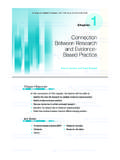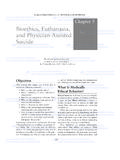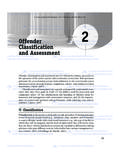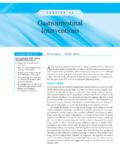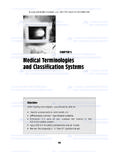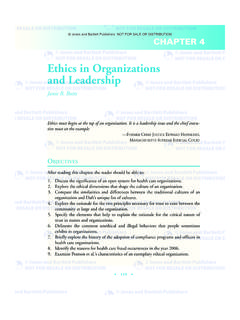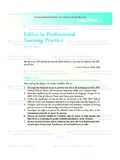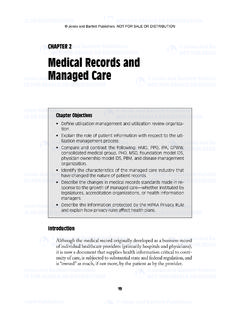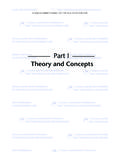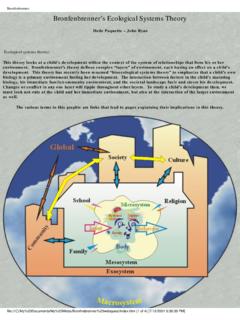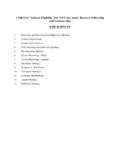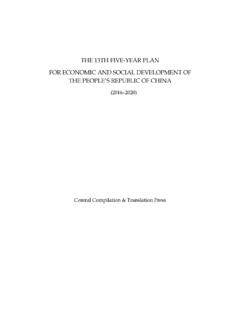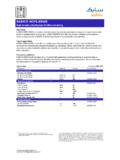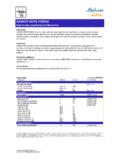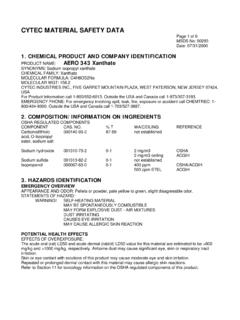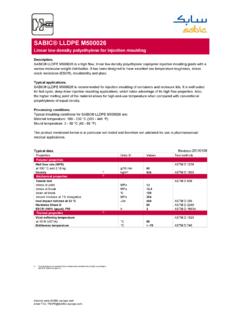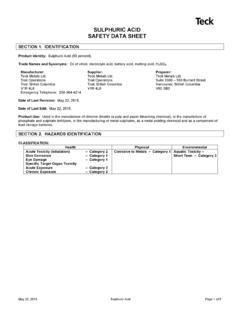Transcription of Aging, Health, and the Environment: An Ecological …
1 aging , health , and theEnvironment:An Ecological Model2 CHAPTER39 INTRODUCTIONR esearch in the epidemiology of aging addresses a variety of topics thatare related to health , functioning, and longevity. Leading areas of researchinclude the study of the effects of age and aging on survival and mortality;physical functioning and activities of everyday life; cognitive functioning;depression and other psychosocial disorders; falls and injuries; and, ofcourse, disease and comorbidities. In each case, the central question is towhat extent and for what reasons are some people and, indeed, some pop-ulations, able to do well as they age, while others are not. Moreover, thereis a strong interest in learning how these age-associated patterns of Health, functioning, and longevity are affected by differences in geography orplace, gender, race, ethnicity, and socioeconomic status.
2 Epidemiological research in aging has drawn from a wide range of sci-entific disciplines, including the biologic, behavioral, social, and environ-mental health sciences. In this chapter, an Ecological modelis proposed as acomprehensive framework to summarize the diversity of that research andto provide a sense of the big picture. aging represents a complex blend-ing of physiological, behavioral, social, and environmental changes thatoccur at both the level of the individual and at the level of the wider com-munity. An Ecological model, we believe, is ideally suited to describe andexplain that complex 4/19/05 2:04 PM Page 39 The Ecological model has a long history in the biologic, behavioral,social, and health sciences (Bronfenbrenner, 1979; McLeroy, Bibeau,Steckler, & Glanz, 1988; Sallis & Owen, 1997; Green & Kreuter, 2004).
3 Depending on the time and discipline, the model has taken differentforms. Some forms of the model highlight the connections among bio-logic, behavioral, and social factors, while other forms emphasize the sig-nificance of the social and physical environments the context. Elements of the model are reminiscent of the components of agent, host, and environment that make up the traditional epidemiologicalperspective. It is important to note that the word Ecological also has beenused in epidemiology to characterize a largely descriptive approach to pop-ulation health that is based on associations between, on the one hand, asummary measure of the population such as per capital consumption ofhigh-fat foods, and, on the other hand, the incidence or mortality rate ofsome health outcome, such as colorectal cancer (Morgenstern, 1998).
4 Thisapproach often has been used for international comparisons and, moreimportantly, as a way of generating hypotheses that are then tested directlyin case-control or prospective studies of individual consumption patternsand disease outcomes among people in that population. In some cases,such aggregate or group-level associations found in the population havebeen used incorrectly as evidence that specific individuals in those popula-tions who consume high-fat diets are themselves at elevated risk forcolorectal cancer. This, of course, is an example of the ecologic fallacy falsely generalizing from associations found at the level of the populationto associations found at the level of the individual. It is fair to say that theprospect of committing this fallacy has discouraged and even intimidatedsome researchers from conducting systematic investigations of populationhealth a point to which we will return in later chapters.
5 THE Ecological MODEL AN OVERVIEW Today, there is a renewed interest in the utility of an Ecological approachin public health and epidemiology. Recent position statements by leadingscientific bodies, including the National Institutes of health , the Na-tional Academy of Sciences, and the Institute of Medicine, are based onthe Ecological model as a framework to characterize and to encourage40 CHAPTER2 aging , health , AND THEENVIRONMENT26559_CH02_039_084 4/19/05 2:04 PM Page 40multidisciplinary work in the health sciences. The Ottawa Charter onHealth Promotion also uses the Ecological model as a foundation for itsrecommendations ( ).Although there are different versions of the Ecological model, the versionincluded in Healthy People 2010, a government document that outlinesthe public health agenda for the first part of the this century,includes the key elements of the Ecological model, as shown in Figure 2 1( Department of health and Human Services, 2000a).
6 An Ecological model is based on the assumption that patterns of healthand well-being are affected by a dynamic interplay among biologic, behav-ioral, and environmental factors, an interplay that unfolds throughout thelife course of individuals, families, and communities (Smedley & Syme,2000). This model also assumes that age, gender, race, ethnicity, andsocioeconomic differences shape the context in which individuals func-tion, and therefore directly and indirectly influence health risks andresources. In addition, the Ecological model serves to identify multiplepoints of possible intervention in public health , from the microbiologic tothe environmental levels, to postpone the risks of disease, disability, anddeath; and enhance the chances for health , mobility, and longevity.
7 Themetaphor of the Chinese box (boxes within boxes) has been used bysome researchers to capture the multilevel, integrated quality of the ecolog-ical model (Susser & Susser, 1996, p. 676): The outer box may be thoughtof as representing the overall physical environment which, in turn, con-tains societies and populations (the epidemiological terrain), single indi-viduals, and individual physiological systems, tissues, and cells, and finally(in biology) molecules. Whether referred to as eco-epidemiology, socialTHEECOLOGICALMODEL ANOVERVIEW41 FIGURE 2 1 Ecological Model. Determinants of health (Detail). (From of health and Human 4/19/05 2:04 PM Page 41ecological, or ecosocial, in each case, the value of viewing epidemiologyand public health in a broader historical, social, economic, political, andenvironmental context is underscored (Susser & Susser, 1996; Stokols,1992; Krieger, 2001).)
8 An Ecological model has been used to describe and explain the effects ofmultilevel factors on both the causes (or etiology) of health conditions aswell as on the consequences (or course) of those conditions. Later, we willexamine the age-associated causes of major health conditions, such as car-diovascular disease, cancer, diabetes, Alzheimer s disease, and osteoarthri-tis. We will also examine the extent to which the course of those conditionscontributes to patterns of health , functioning, and longevity. The likeli-hood of disability among people and populations has received specialattention and has been explained as a multilevel process the disablementprocess. The process, as described originally by Verbrugge and Jette(1994), is initiated by a pathology with an associated level of physiologicalor cognitive impairment that may lead, in turn, to functional limitationsand, ultimately, to a disability (Figure 2 2).
9 The transition from pathologyto disability, especially from functional limitations to disability, dependson the intersections of the individual s capacity and behaviors, as well asthe relative resources and demands of the social and physical environ-ments. Functional limitations are defined as restrictions or difficulty in theperformance of generic tasks that typically involve upper- and lower-bodystrength, balance, fine dexterity, and walking speed. Disability, on the42 CHAPTER2 aging , health , AND THEENVIRONMENTFIGURE 2 2 The Disablement ModelPathologyImpairmentFunctional LimitationDisabilityDisease, injury,Dysfunction andRestrictions in basic Difficulty doingcongenitalstructuralphysical and mental activities of daily lifedevelopmentalabnormalities inactions (ambulate, (personal care,conditionspecific bodyreach, grasp, climb householdsystemsstairs, speak, see management,musculoskeletal,standard print)job, hobbies)cardiovascular, etc.
10 ExampleDenervatedAtrophyCannot pullChange of job; canmuscle in armmusclewith armno longer swimdue to traumarecreationallyNote. From The Disablement Process, by L. Verbugge and A. M. Jette, 1994, Social Science &Medicien, 38(1), pp. 1 14. Adapted with 4/19/05 2:04 PM Page 42other hand, refers to the inability to perform specific social roles in every-day life because of health or physical problems. The Verbrugge Jette Disablement Model (1994) has served as animportant frame of reference for research in the epidemiology of agingand disability. In fact, a recent Cooper Conference in Dallas, Texas, usedthe model as the basis and foundation for a symposium on the signifi-cance of physical activity as a strategy to prevent physical disablement inolder adults (Rejeski, Brawley, & Haskell, 2003).

